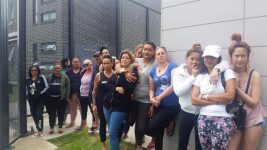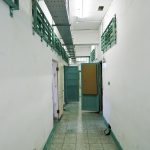Immigration Detainees on Hunger Strike Over Brutality and Deplorable Conditions

On Wednesday, over 350 detainees at Perth’s Yongah Hill Immigration Detention Centre entered the tenth day of their hunger strike over conditions at the facility. Key grievances are guard brutality, the arbitrary nature punishment and government powers to detain indefinitely.
And as of Monday, detainees across the country joined them. Those in Villawood Immigration Detention Centre and Brisbane Immigration Transit Accommodation began to hunger strike, while those at Melbourne Immigration Transit Accommodation (MITA) resumed their earlier strike.
Among those who are going without food are over one hundred New Zealanders, who, until recently, made up the largest cohort of people in onshore immigration detention, following changes to the laws around deporting noncitizens on character grounds that were made at the end of 2014.
Villawood detainees have issued a list of human rights concerns to the immigration department, which include being placed in centres located away from their families, detaining individuals with no pending criminal or immigration matters and the use of isolation and restraints by guards.
The Australian Border Force (ABF) said in a statement on Monday that “there is no mass hunger strike within the Australian immigration detention network, or at any immigration centres”. And it “strongly” refutes claims that the conditions in the facilities “are inhumane or brutal”.
Mass hunger strike continues
Refugee Action Coalition spokesperson Ian Rintoul said some hunger strikers from Yongah Hill were taken to the hospital on Monday. “People are getting a bit tired and weak. But, they’re hanging in there for now,” he explained. “It’s always difficult: how long people can sustain it.”
The long-term refugee rights advocate estimated that there are around 1,000 detainees involved in the hunger striking at facilities across the nation. And its deplorable living conditions, the increasing militarisation of centres and the overriding power of the minister that’s behind the strikes.
Some of the detainees have been kept inside these onshore detention facilities for up to eight years. However, numbers have recently swelled due to the 501ers, who are resident noncitizens who’ve fallen short of the Abbott/Turnbull/Morrison government’s draconian deportation program.
For now, Mr Rintoul continued, the government is “just trying to wait it out”. He added that they’ve been putting out statements denying the hunger strikes, as well as assaults perpetrated by guards. But, in regard to an initial strike at MITA, the government has started to make some concessions.
Shifting the problem
Around 200 detainees at MITA North – the new high security compound at the Broadmeadow’s immigration facility – began a hunger strike on 8 January, in response to the harsh conditions there, which are even worse than transferees from Maribyrnong had previously been subjected to.
The government shut down the high security Maribyrnong Immigration Detention Centre at the beginning of the month. This followed the closure of the notorious Christmas Island facility in October last year. And there are also plans to shut Blaxland compound at Villawood mid-year.
However, Mr Rintoul denounced these closures as sleight-of-hand, as the government has simply “opened high security compounds at MITA and Yongah Hill, which are now being used very similarly to the way Christmas Island was used”.
Immigration centre brutality
The hunger strike at MITA North commenced at the same time that footage emerged from MITA South compound that showed a detainee being set upon by five Serco guards and forcibly removed from the mess hall, after he allegedly asked for some garlic sauce to go with his meal.
Following the incident, the ABF refuted “claims that a detainee at MITA was physically restrained for asking a question about his meal”. It further asserted that reasonable force was used during the incident in accordance with guidelines and procedures.
The MITA detainees suspended their initial hunger strike after the ABF met one of their demands, which was to supply them with televisions in their rooms. And on Tuesday, Mr Rintoul told Sydney Criminal Lawyers that these detainees are now waiting for further demands to be met.
Shirking responsibility
In December 2014, the Coalition government amended section 501 of the Migration Act 1958, so a noncitizen is now automatically deported for any number of sentences amounting to 12 months or more, rather than the previous 24 months.
The result has been that a large number of long-term Australian residents have had their visas revoked for multiple petty crimes. And while Rintoul states that this was a policy aimed at refugees for the most part, it has heavily affected the New Zealander population in this country.
Mr Rintoul sees this as a form of double punishment. “It’s been a deliberate move by the government to change the Migration Act, so that they’ve got a whole other avenue of punitive measures that they can take against people who are permanent residents.”
The Migration Act was further amended so that under section 501 a noncitizen can also be deported without a conviction if the minister reasonably suspects they’re associated with crime, while section 116 now allows a noncitizen to be turfed out of the country if they pose a risk to “good order”.
Deporting Kiwis in droves
The latest Department of Home Affairs immigration detention figures are from 30 November last year. They outline that 1,327 individuals were in mainland detention: 405 were 501ers, 427 people were being detained for “illegal maritime arrival” and 456 were inside for other reasons.
At that time, the greatest number of people being held in onshore detention facilities were Iranians, numbering 168 detainees. And this was closely followed by New Zealanders, totalling 154 people in detention.
Indeed, between June 2016 and September last year, Kiwis in Australia made up the largest group of people being held in onshore immigration detention centres, whereas prior to the character ground amendments, they even didn’t rate as a separate group.
According to the Home Affairs Department, since the amendments to the Migration Act were made, visa cancellations on character grounds have increased by over 1,400 percent. Over the year 2017-18, 907 people were deported on these grounds, with 50 percent – or 453 individuals – being Kiwis.
“The hunger strike is big news in New Zealand,” Mr Rintoul said, as Kiwis are one of the largest groups involved. And he added that New Zealanders are not the only people that the new deportation rules are affecting.
“There’s a Jordanian guy, who’s been here forty years. All his family are here. He’s got no connection with Jordan. And they’re talking about trying to deport him, even though everything is here,” he concluded.







